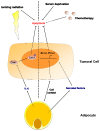Implication of tumor microenvironment in chemoresistance: tumor-associated stromal cells protect tumor cells from cell death
- PMID: 22949815
- PMCID: PMC3431813
- DOI: 10.3390/ijms13089545
Implication of tumor microenvironment in chemoresistance: tumor-associated stromal cells protect tumor cells from cell death
Abstract
Tumor development principally occurs following the accumulation of genetic and epigenetic alterations in tumor cells. These changes pave the way for the transformation of chemosensitive cells to chemoresistant ones by influencing the uptake, metabolism, or export of drugs at the cellular level. Numerous reports have revealed the complexity of tumors and their microenvironment with tumor cells located within a heterogeneous population of stromal cells. These stromal cells (fibroblasts, endothelial or mesothelial cells, adipocytes or adipose tissue-derived stromal cells, immune cells and bone marrow-derived stem cells) could be involved in the chemoresistance that is acquired by tumor cells via several mechanisms: (i) cell-cell and cell-matrix interactions influencing the cancer cell sensitivity to apoptosis; (ii) local release of soluble factors promoting survival and tumor growth (crosstalk between stromal and tumor cells); (iii) direct cell-cell interactions with tumor cells (crosstalk or oncologic trogocytosis); (iv) generation of specific niches within the tumor microenvironment that facilitate the acquisition of drug resistance; or (v) conversion of the cancer cells to cancer-initiating cells or cancer stem cells. This review will focus on the implication of each member of the heterogeneous population of stromal cells in conferring resistance to cytotoxins and physiological mediators of cell death.
Keywords: apoptosis; cancer; chemoresistance; microenvironment.
Figures





References
-
- Meads M.B., Gatenby R.A., Dalton W.S. Environment-mediated drug resistance: A major contributor to minimal residual disease. Nat. Rev. Cancer. 2009;9:665–674. - PubMed
-
- Basak G.W., Srivastava A.S., Malhotra R., Carrier E. Multiple myeloma bone marrow niche. Curr. Pharm. Biotechnol. 2009;3:345–346. - PubMed
-
- Roodhart J.M., Daenen L.G., Stigter E.C., Prins H.J., Gerrits J., Houthuijzen J.M., Gerritsen M.G., Schipper H.S., Backer M.J., van Amersfoort M., et al. Mesenchymal stem cells induce resistance to chemotherapy through the release of platinum-induced fatty acids. Cancer Cell. 2011;3:370–383. - PubMed
-
- Castells M., Thibault B., Mery E., Golzio M., Pasquet M., Hennebelle I., Bourin P., Mirshahi M., Delord J.P., Querleu D., et al. Ovarian ascites-derived Hospicells promote angiogenesis via activation of macrophages. Cancer Lett. 2012 in press. - PubMed
-
- Lis R., Touboul C., Mirshahi P., Ali F., Mathew S., Nolan D.J., Maleki M., Abdalla S.A., Raynaud C.M., Querleu D., et al. Tumor associated mesenchymal stem cells protects ovarian cancer cells from hyperthermia through CXCL12. Int. J. Cancer. 2011;3:715–725. - PubMed
Publication types
MeSH terms
LinkOut - more resources
Full Text Sources
Other Literature Sources

